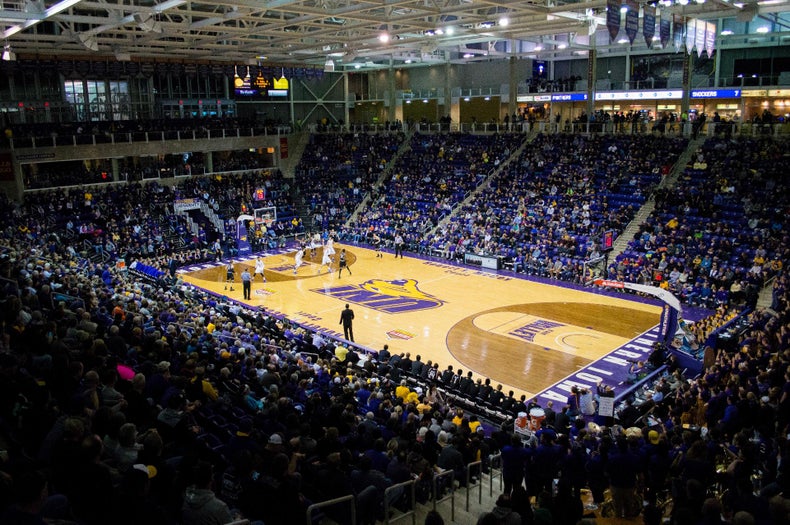Like the diversity in college basketball teams, the same could be said about college basketball betting. Below, you’ll find some of the most common betting practices in college basketball.
NCAAB Moneyline: NCAAB Moneyline Betting is wagering upon the outright winner of the contest. Basically, you are picking which team will win the contest after the game has concluded. The Moneyline features an underdog and a favorite. The favorite is defined by the – symbol next to their name, while the underdog is defined by the + symbol.
In a game between Kentucky and Duke, one would be considered the underdog and one would be the favorite. So, Kentucky would be listed at -110, while Duke would be the underdog at +120. Betting on the underdog provides greater value as there is more risk. Betting on the favorite provides less return because they are expected to win. In order to win a Moneyline bet, the team you selected to win must win the game.
NCAAB Spreads: The spread refers to the number of points a team is expected to win or lose by. Like the Moneyline, a negative number means that team is the favorite, while a positive number equates to the underdog. In a game between Kentucky vs. SMU, Kentucky’s spread would be -18. This means that they are the favorite and to win the bet, Kentucky must win by 19 points.
The team can win the game but you lose the bet if they do not score more points than what’s listed on the spread, known as covering. So, if Kentucky wins by 19 points, they have covered. If they win by 17 points, they won in the game but lost the bet because they did not cover the spread. On the opposite side, the underdog SMU can win the bet if they lose by 17 points or less. If they lose by 18 points they do not cover. If SMU wins the game, they automatically cover on the spread because they were listed at +18. Lastly, if Kentucky wins by 18 points, the bet is considered a tie, known as a push.
NCAAB Totals: College Basketball Totals, known as the over/under (O/U) is the act of betting on a certain number. The most common O/U bet you can wager on is the total score. If Duke is playing Kentucky, you will see the O/U listed at 162. If you think there will be more than 162 points scored in the game, you would bet the over. If you think 161 points or fewer will be scored, then you’ll bet the under.
O/U totals can also refer to a teams’ specific point totals as well. You can also wager on Duke’s personal O/U point total, as well as Kentucky’s. Betting on the totals is a popular method in college basketball. With time winding down, you could be banking on a team to hit that final bucket to reach the over, or to miss so the total score remains under.
NCAAB Prop Betting: College Basketball prop betting usually relates to smaller battles in the game, rather than the outcome or final score. If you’re wagering on a prop bet, you might be betting on who will win the opening tip off or which player will dish the first assist. Prop betting has many choices, featuring over/under totals, or straight up bets – it’s one of the most interesting and unpredictable type of bets you can make.
Prop bets (or proposition bets) are bets on specific occurrences in the game. What’s fun about prop betting is that there is no limit to the bookmakers’ imagination. If there is a possibility of a certain occurrence and the bookmaker can offer odds, chances are you will see a wager option.
Live Bets: Live Betting is betting on the game while it has already started. Also known as In-Play Betting, bettors who decided to bet on games already in-play usually like to see the flow of the game before placing a bet. In the NCAA, bettors want to see the opening minutes of the contest to gauge whether or not they should place a bet. If you’re placing a bet after the game has started, expect odds to change in relation to how the game is currently unfolding.
If Duke’s opening ML was -120 before the game has started, those odds wil change throughout the game through live-betting. If Duke continues to dominate and lead, their odds will continue to drop because there is less time on the clock, they are winning and there is less chance for a loss. With Duke leading and time winding down on the clock, you will see their odds on the ML change, going from -120 to -500 if the lead is big enough and the time left in the game. Of course, odds vary by team, score, opponent, etc.
NCAAB Futures: If you’re interested in betting on NCAAB futures, you are betting on upcoming events. Normally, futures bets relate to championships, awards, and teams’ over/under in victories. A common futures bet is the NCAA Championship. Before the season begins, you can bet on who you think will win the NCAA Championship well in advance of the actual tournament.
Bettors like to do this because it usually offers better odds than when the competition has dwindled. Before the season starts, you could select Duke to win at +700. If they reach the Final Four, Duke’s odds to win the Championship will change to +250 (or something similar) because there are fewer teams in the tournament and their odds of winning have improved. You can also bet on Conference Championship winners, Award Winners, and other future bets well before the season.
NCAAB Parlays: College Basketball parlays is the act of combining multiple bets into one single bet to increase your odds. You can bet on Duke, Baylor, and UNC to win straight up in individual bets. However, if you combine those bets and they are all correct, you will see a great return.
The downside to parlay betting is that one slip-up ruins the entire bet. So, if 2/3rds of your bet are right but 1/3rd is wrong, you lose the entire bet. College Basketball parlays are popular among the betting community because you can combine several bets into one for increased odds and they are perfect for bettors who want to wager smaller amounts at an increased payout.
 |
|
